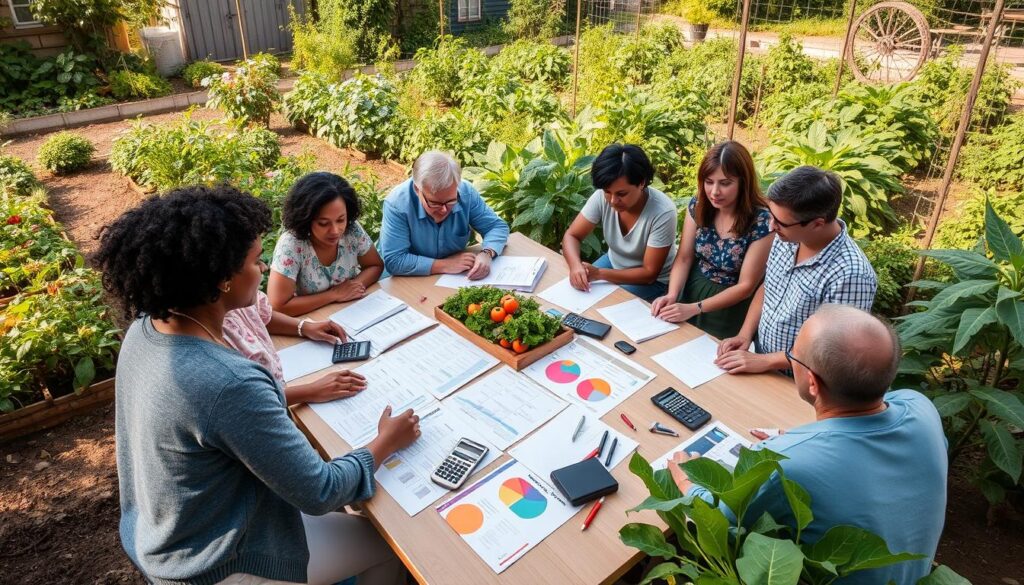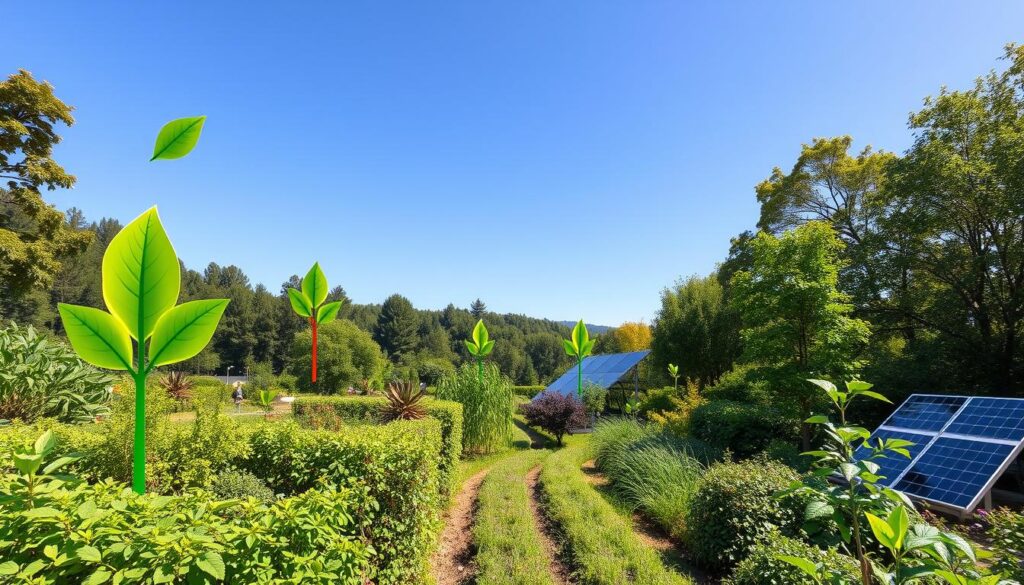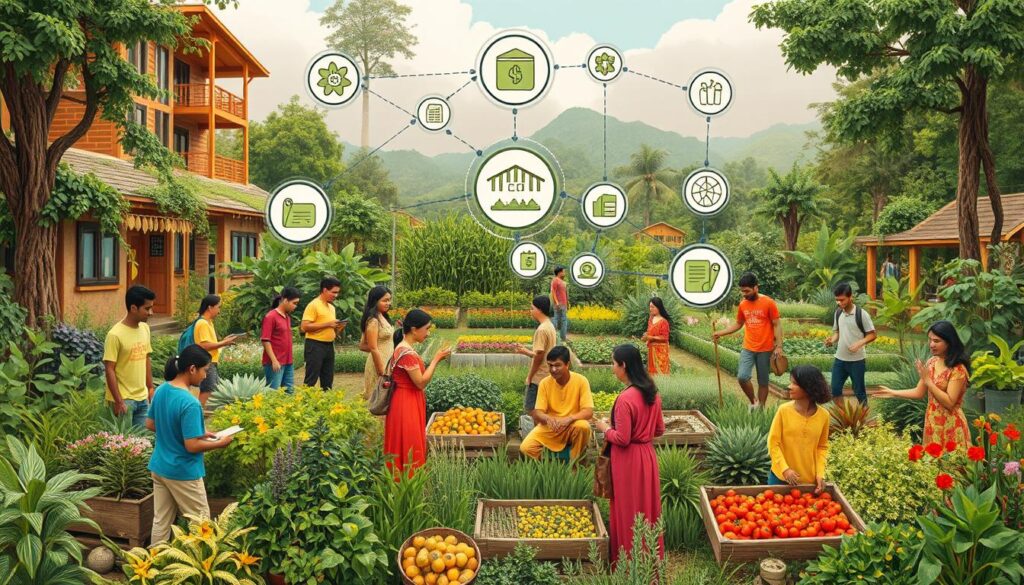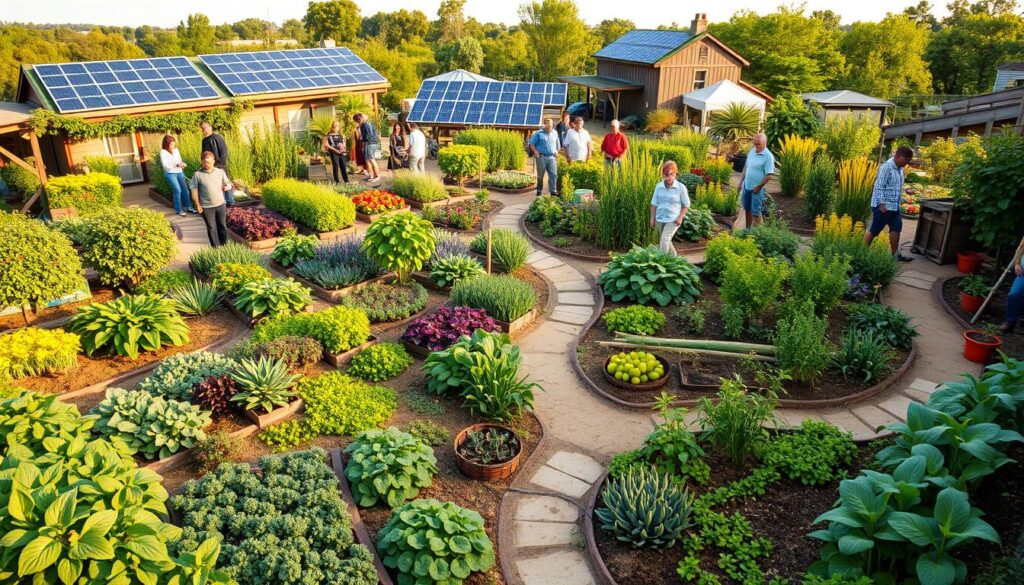In countries like Sweden, 50% of monthly budgets go to food and housing. This shows we need new financial ideas. Permaculture cooperative finance is a great option. It mixes sustainable investing with community planning to build strong communities.
By using permaculture in finance, we can make systems better for our planet and people. This way, we can create more efficient and green financial models.
Key Takeaways
- Permaculture cooperative finance combines sustainable investing and community financial planning to create resilient communities.
- Food and housing constitute approximately 50% of the average person’s monthly budget in developed nations.
- Permaculture principles can be applied to financial systems to design more efficient and environmentally friendly models.
- Community financial planning is essential for creating self-reliant communities that promote sustainable investing.
- Permaculture cooperative finance has the potential to reduce dependence on employment for housing and food needs.
- Cooperative finance models can provide a greater emotional support network and more flexible distribution of resources.
Permaculture cooperative finance can lead to a better future for everyone. It changes how we see finance and community growth. It supports sustainable investing and planning that helps both people and the planet.
Understanding Permaculture Principles
Permaculture is a way to design systems that are good for the planet and people. It focuses on using resources wisely and reducing waste. By choosing green financing and eco-friendly investments, we can build a better future.
The core of permaculture is based on three main ethics: Earth Care, People Care, and Fair Share. These guide how we design systems, from small gardens to big farms. By following these principles, we can make our food systems more sustainable and strong.
- Producing no waste
- Using edges and valuing the marginal
- Integrating elements rather than segregating them
These principles help us invest in a sustainable way. They are key for a regenerative economy. By using them, we can make our food systems more resilient and sustainable, which is good for everyone.
What is Cooperative Finance?
Cooperative finance is all about working together and being socially responsible. It’s owned by its members, who share resources and risks. This way, everyone works towards common goals. It focuses on collaborative finance models, putting the community first, not just profits.
The Financial Permaculture Institute helps grow permaculture businesses. They use a special finance approach. This method is about socially responsible money management, caring for the community and the environment.
Overview of Cooperative Financial Models
Cooperative financial models help the community. They follow community financial planning, working together for financial goals. The benefits include:
- Shared resources and risks
- Collaborative decision-making
- Socially responsible money management
- Community-oriented operations
Benefits of Cooperative Structures
Cooperative structures offer many advantages. They help with financial stability and growth. Members can combine their resources and share risks. This makes reaching financial goals easier.
Cooperative structures also support collaborative finance models and socially responsible money management. These practices benefit the community and the environment.
| Benefits of Cooperative Structures | Description |
|---|---|
| Financial Stability | Cooperative structures can provide increased financial stability and growth |
| Social Responsibility | Cooperative structures promote socially responsible money management and community-oriented operations |
| Collaborative Decision-Making | Cooperative structures involve collaborative decision-making and shared resources and risks |
The Intersection of Permaculture and Finance
Permaculture and finance meet in a key area, aiming to build strong, self-sufficient communities. Financial permaculture aims for total economic return, making the whole system work better. This idea ties closely to permaculture cooperative finance, which focuses on green investing and boosting local economies.
By blending financial sustainability with local support, permaculture finance helps build a better economy. This is done through several ways, including:
- Investing in local businesses and projects
- Backing community-led efforts and cooperatives
- Pushing for green practices and cutting down on waste
As sustainable investing grows, the role of permaculture finance becomes even more vital. A holistic finance approach helps build a stronger, greener economy. 
Integrating Financial Sustainability
Adding financial sustainability to permaculture finance is key for a regenerative economy. This means looking at the return for investors, communities, and nature. It ensures our money choices help both people and the planet.
Supporting Local Economies
Backing local economies is central to permaculture finance. Investing in local ventures makes communities stronger and more self-sufficient. It also encourages green practices and cuts waste, helping build a greener economy.
| Strategy | Benefits |
|---|---|
| Investing in local businesses | Supports community growth, promotes green practices |
| Supporting community-led projects | Boosts community involvement, reduces waste |
| Encouraging sustainable practices | Lessens environmental harm, fosters a regenerative economy |
Key Benefits of Permaculture Financial Cooperatives
Permaculture financial cooperatives offer big wins for the environment and economy. They push for green practices and team up on finance. This helps cut down on waste and supports green investments.
These cooperatives are great for those who want to invest in a green way. They let investors back sustainable projects and still make money. Crowdfunding and other team efforts help get funds for green projects, bringing people together.
Environmental Impact
Permaculture financial cooperatives make a big difference for the planet. They support farming that’s good for the earth and cut down on waste. This helps fight climate change. They also get funding for projects that save land and protect nature.
Economic Resilience
These cooperatives also help the economy by offering solid financing for green projects. They use group efforts to lower the risks of loans, making the economy more stable. This way, green investments can grow and support sustainable businesses and communities.
In summary, permaculture financial cooperatives are a big step towards a greener future. They offer green financing and team efforts, helping build a stronger, more sustainable economy.
Steps to Establish a Permaculture Cooperative
Starting a permaculture cooperative needs careful planning and teamwork. First, gather a team of people who share your vision for a regenerative economy. This team will help write a mission statement and a business plan. The plan should focus on community financial planning and socially responsible money management.
Creating a mission statement is crucial. It should show what the cooperative values and aims for. This statement will guide the cooperative’s decisions, keeping the community’s best interests in mind.

Then, write a business plan that outlines the cooperative’s financial and operational details. This plan should match the cooperative’s unique needs and goals. It should include a detailed budget and financial forecasts.
When making the business plan, consider these points:
- Plan the cooperative’s finances carefully, focusing on its goals and objectives
- Use socially responsible money management to benefit the community and environment
- Build a regenerative economy that supports sustainable growth and long-term success
Membership Structure in Cooperatives
Cooperatives need clear roles for members and fair voting rules. They use collaborative finance models to manage money well and plan for the community. This helps them make choices that help everyone involved.
Cooperatives give each member one vote, no matter their investment or work hours. This way, everyone has an equal say, creating a sense of belonging. For instance, community-supported agriculture cooperatives use this to decide on farming plans and resource use.
Being part of a cooperative means more than just voting. Members help shape the business plan and share profits based on their input. This teamwork helps achieve shared goals. Successful cooperatives include:
- Worker cooperatives, where members own and control the business
- Consumer cooperatives, where members pool resources to purchase goods and services
- Credit unions, which provide financial services to members at competitive rates
Today, over 18 million workers in the US own part of their workplace. Cooperatives exist in almost every industry globally. By focusing on collaborative finance models and socially responsible money management, they aim for a fairer economy. The cooperative movement is growing, and it’s key to keep planning for the community and engaging members for success.
| Cooperative Type | Number of Members | Industry |
|---|---|---|
| Worker Cooperative | 18 million | Various |
| Consumer Cooperative | 3 million | Food, Hospitality, Healthcare |
| Credit Union | 100 million | Finance |
Funding Sources for Permaculture Cooperatives
Permaculture cooperatives need money to start and grow. There are many ways to get this funding. Options like crowdfunding and grants are great for these projects. They help create a greener economy.
The USDA has programs like the Organic Agriculture Research and Extension Initiative (OREI) grants. They offer $44 million in funding. The Risk Management Education Partnerships Program (RMEPP) also has $3 million for risk education. Plus, the Organic Transitions Program (ORG) has $7.5 million for grants this year.
Other funding options include:
- The Beginning Farmer and Rancher Development Program (BFRDP), with an estimated total grant funding of $24 million available this year
- The Rural Business Development Grant Program (RBDG), which supports businesses with fewer than 50 employees and less than $1 million in gross revenues
- The Gus Schumacher Nutrition Incentive Program (GusNIP), which offers $5.28 million available for the Produce Prescription Program this year

These funds help permaculture cooperatives grow. They support sustainable development and a regenerative economy. By using these green financing options, cooperatives can flourish and help their communities.
Legal Considerations for Cooperatives
Cooperatives face complex legal and tax issues. It’s crucial to grasp cooperative law and tax rules. Collaborative finance models offer a way to manage money responsibly. They help cooperatives follow the law and support sustainable growth.
Some important points for cooperatives include:
- Understanding cooperative law and its impact on business
- Handling tax rules and ensuring legal compliance
- Using community financial planning for sustainability
By focusing on socially responsible money management and collaborative finance models, cooperatives can positively affect their communities. This approach builds trust and cooperation among members. It leads to a more sustainable and fair future.
The success of a cooperative depends on balancing financial goals with social and environmental duties. By taking a comprehensive approach to community financial planning and valuing collaborative finance models, cooperatives can make a difference. They ensure their own sustainability while benefiting their communities.
| Cooperative Type | Key Characteristics |
|---|---|
| Housing Cooperative | Member-owned, non-profit, and focused on providing affordable housing |
| Worker Cooperative | Member-owned, democratic, and focused on promoting worker ownership and control |
Building a Cooperative Vision
To make a permaculture cooperative finance system work, you need a clear vision and community support. The Financial Permaculture Institute has tools to help grow permaculture businesses. They focus on sustainable investing and building a regenerative economy.
Here are some ways to build a cooperative vision:
- Engage the community in design and decision-making
- Set long-term goals and make a plan to reach them
- Support permaculture cooperative finance and sustainable investing
Cooperatives can build a better economy by working together and sharing resources. They aim to empower people to invest in their communities. This way, they help create a stronger, more thriving community.

| Cooperative | Annual Revenue | Charitable Contributions |
|---|---|---|
| Valley Alliance of Worker Co-operatives (VAWC) | $7 million | $35,000 |
Financial Literacy in Cooperative Members
Financial literacy is key for cooperative members to succeed. It helps them make smart money choices. Community financial planning and socially responsible money management are vital. They teach how money choices affect the community and environment.
Collaborative finance models also help. They focus on working together and sharing resources. This boosts financial literacy among members.
Training and financial resources are essential. They help members learn to manage their money well. This includes making smart investments and supporting the cooperative’s financial health.
By focusing on community financial planning and teamwork, cooperatives can create a fair and sustainable financial system. This benefits all members.
Here are some ways to improve financial literacy in cooperatives:
- Provide training workshops and educational materials on money management and planning.
- Give members access to financial tools like loans and grants.
- Support cooperative banking and credit unions to foster teamwork and shared resources.
By using these strategies, cooperatives can empower their members. This prepares them for the future and helps the cooperative and community thrive.
| Strategy | Benefits |
|---|---|
| Training workshops | Improved financial literacy, increased confidence in financial decision-making |
| Access to financial resources | Increased access to capital, support for member initiatives |
| Collaborative finance models | Promotes mutual support, shared resources, and financial sustainability |
Agricultural Practices within Cooperatives
Agricultural practices in cooperatives support sustainable growth. They use permaculture design strategies and crop rotation and diversity. These methods cut down on waste and support eco-conscious investment strategies. This is key for a regenerative economy. Cooperatives also use green financing options to help local economies and work towards a greener future.
Some important ways to support sustainable development in agricultural cooperatives include:
- Implementing permaculture design principles to reduce waste and promote biodiversity
- Adopting crop rotation and diversity practices to improve soil health and reduce the need for external inputs
- Utilizing green financing options to support sustainable agricultural practices and promote eco-conscious investment strategies
By using these strategies, cooperatives help build a more 
| Strategy | Benefits |
|---|---|
| Permaculture design principles | Reduced waste, improved biodiversity |
| Crop rotation and diversity | Improved soil health, reduced need for external inputs |
| Green financing options | Support for sustainable agricultural practices, promotion of eco-conscious investment strategies |
Marketing Strategies for Permaculture Cooperatives
Marketing is key for permaculture cooperatives to thrive. They use models like collaborative finance and socially responsible money management. This attracts people who share their vision. A strong brand identity is crucial. It sets them apart and shows their values and goals.
Creating a Brand Identity
A brand identity can be built in several ways. For example:
- Creating a unique logo and visual style
- Writing a compelling mission statement and value proposition
- Keeping a consistent tone and voice in all marketing
This helps cooperatives stand out and build a dedicated community.
Community Outreach and Education
Reaching out and educating the community is essential. Permaculture cooperatives can do this by:
- Hosting workshops and training sessions
- Partnering with local schools and groups
- Offering online resources and webinars
This way, they can teach about the benefits of working together financially. It encourages people to be part of their financial future.
| Marketing Strategy | Benefits |
|---|---|
| Collaborative finance models | Increased community engagement, improved financial literacy |
| Socially responsible money management | Enhanced reputation, increased trust among community members |
| Community financial planning | Improved financial stability, increased sense of ownership |
Measuring Success in Financial Cooperatives
Success in financial cooperatives is measured in many ways. It looks at both money and social impact. Strategies like permaculture finance and sustainable investing help achieve this goal. Cooperatives track important signs like how much money they make and how active their members are.
A focus on the long term is key in a regenerative economy. This is shown in the Kachuwa Impact Fund’s long investment plans. It lets cooperatives grow slowly but surely, focusing on lasting benefits.
Some cooperatives have done very well. Namasté Solar made over $40 million in its first ten years. The Kachuwa Impact Fund plans to invest 60% in real estate that helps the environment. These examples show how permaculture finance can lead to sustainable growth.
Cooperatives measure success in different ways. They look at:
- Money, like how much they make and their profits
- Social impact, like jobs created and community involvement
- Environmental efforts, like using renewable energy and reducing waste
By looking at everything together, cooperatives can meet their financial and social goals. This supports a healthy economy that helps both people and the planet.
Future Trends in Permaculture Finance
The future of permaculture finance will blend technology with changing consumer tastes. As people care more about the planet, they’ll want green financing options more. This will lead to collaborative finance models that focus on the environment and society.
Investing in permaculture will mean looking at the big picture. It will involve using green financing options and collaborative finance models. These will help fund projects that are good for the planet and communities.
Expect to see more collaborative finance models and green financing options in the future. As more people want to invest sustainably, new eco-conscious investment strategies will emerge. These will put the planet and people first.
Conclusion: The Path Forward for Financial Cooperatives
The permaculture cooperative finance movement is growing fast. We need to keep working together and finding new ways to grow. The Financial Permaculture Institute has tools to help businesses thrive and share wealth fairly.
Investing in a sustainable way and planning for community finances are key. These steps help cooperatives grow strong and support their communities. Groups like Elevate Cooperative offer great deals to help cooperatives save money.
By following permaculture finance, we can solve big problems together. More people joining this effort will lead to a better future. This future is one where everyone has what they need, the planet is healthy, and communities are strong.

